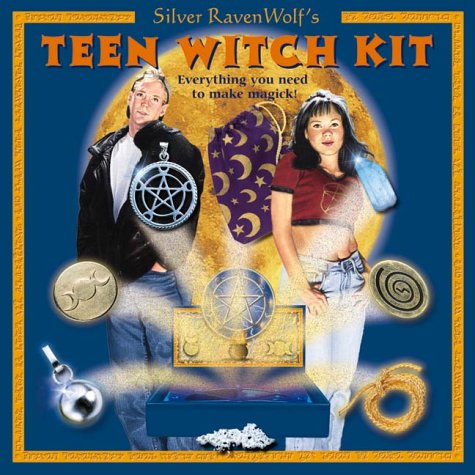|
Spells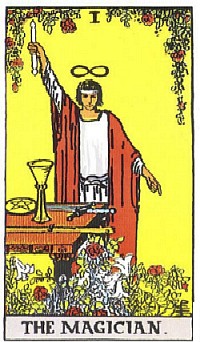 The concept of magic is a wonderful thing, but it doesn't do shit unless you have a practical method for making it work.
The concept of magic is a wonderful thing, but it doesn't do shit unless you have a practical method for making it work. Over roughly 30,000 years of human history, a surprisingly consistent set of basic principles have led to a shockingly inconsistent number of methods for making magic work -- everything from pouring human blood over your head to distilling sexual fluids into alchemical concoctions, speaking forbidden words in dead languages to masturbating over an occult symbol. There are 50 ways to leave your lover, but there are thousands of ways to mess with his or her juju. Such ritualized exercises of supernatural power are known as spells. For a discussion of the effectiveness of magic, you will have to look elsewhere. For ease of narration, we'll more or less assume here that the following approaches more or less work the way they're supposed to. (Unless you'd rather read more or less the same disclaimer more or less every third sentence.) In religion, people tend to believe that only their own practices are effective. But most people who practice occultism believe that you can successfully perform magic using just about any approach that conforms to two or more of the basic principles:
Within these parameters, you will find a wide variety of actual practices that range from the sublime to the ridiculous to the even more ridiculous. You will note that "dignity" is not one of the basic principles of spellcasting. In fact, dignity is frequently an impediment.
Ritual Magic Spells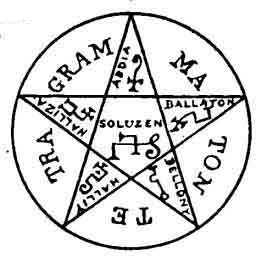 Ritual magic is the most theatrical form of magic, but in many ways, the least impressive. Ritual magicians are usually following a script written by someone else and just going through the motions. That's OK, however. Most occultists will tell you it's like driving a car. You may not be able to rebuild a catalytic converter, but if you follow the directions, you can usually count on it to work.
Ritual magic is the most theatrical form of magic, but in many ways, the least impressive. Ritual magicians are usually following a script written by someone else and just going through the motions. That's OK, however. Most occultists will tell you it's like driving a car. You may not be able to rebuild a catalytic converter, but if you follow the directions, you can usually count on it to work. Modern Wiccan witches keep a type of spellbook known as a Book of Shadows, with sometimes elaborate directions for fairly basic ritual magic. "Fairly basic" in this context means that you generally don't have to kill or dismember anything to get the job done. A typical spell uses candles, stones and herbs as ingredients. While Wiccan texts are usually modern in origin, they are sometimes based on much older rites. Ritual magic dates back to very early practices. Spells will often include all five of the basic principles listed above. The Ancient Egyptians, Romans and Greeks all practiced forms of ritual magic. Roman and Greek practices are mostly forgotten today, but Egyptian magic (also known as Hermetic magic) is supposedly at the root of occult secret socieities like the Masons and the Ordo Templi Orientis. The most popular forms originated in medieval times, when the fear of Satan was as widespread as the desire to be bad. Medieval magic books, known as grimoires, often instructed magicians to invoke various demons from Hell. Some demons were more powerful than others, some were specialists in certain kinds of activity, and all of them could be commanded by the correct intonation of their name, and by invoking the power of God (including his secret name, known as the Tetragrammaton) and his angels.
These structures served as circles of protection. You could either contain the summoned entity within the circle, or stand within the circle yourself and keep the entity on the outside. Once all these preliminaries were taken care of, you would then utter something along the following lines (taken from a grimoire of unknown pedigree in the British Museum): I conjure thee, I exorcise thee, thou Spirit Zadkiel, by these Holy Names Hagios O Theos Iscyros Athanatos Paracletus Agla on Alpha et Omega Ioth Aglanbroth Abiel Anathiel Tetragrammaton: And by all other great and glorious, holy and unspeakable, mysterious, mighty, powerful, incomprehensible Names of God, that you attend unto the words of my mouth, and send unto me Pabiel or other of your ministering, serving Spirits, who may show me such things as I shall demand of him in the Name of the Father, and of the Son, and of the Holy Ghost. Amen.
Most famous for his Tarot deck, A.E. Waite recorded the definitive history of the art in his 1913 tome, The Book of Ceremonial Magic, which details rituals that run from the boring to the bloody. A fairly typical example is the "Rite of Lucifuge," which lives up to its ominous sounding name. Taken from a purportedly medieval grimoire, the Rite details in excruciating detail how the magician is to proceed. First, he is ordered to fast for a week. The magician then purchases a piece of hematite, a stone believe to absorb negative energies, in order to protect himself from the impending wrath of the demons he is preparing to summon. The magician obtains a young, virgin goat, adorns it with a verbena garland and a green ribbon, then beheads it according to a strict lunar timetable. According to Waite: The sacrifice must be offered on the scene of the coming evocation, a forlorn and isolated spot free from all interruption. There, with the right arm bared to the shoulder, having armed himself with a blade of fine steel, and having kindled a fire of white wood, the Karcist shall recite the following words in a hopeful and animated manner: The goat is skinned and then everything except the skin is burned to ash. The ashes are cast toward the rising sun while the magician chants more of the above. The magician makes a "Blasting Rod," which is a whole other set of elaborate instructions.
When the night of action has arrived, the operator shall gather up his rod, goatskin, the (hematite), and shall further provide himself with two (verbena) crowns, two candlesticks and two candles of virgin wax, made by a virgin girl and duly blessed. Let him take also a new steel and two new flints, with sufficient tinder to kindle a fire, likewise half a bottle of brandy, some blessed incense and camphor, and four nails from the coffin of a dead child. All these must be carried to the place chosen for the great work, where everything hereinafter laid down must be scrupulously performed and the dread Kabalistic circle must be described in an accurate manner. Lastly, it must be carefully borne in mind that there should be either one or three taking part in the ceremony, the (magician) included, who is the person appointed to address the spirit, holding the Destroying Rod in his hand. The goat skin is cut into strips to form a circle of protection, affixed in place with the aforementioned coffin nails. The magician traces a triangle inside the circle, pointing east, then writes several series of letters on the ground. The candlesticks and verbena are arranged attractively around the design, then specially prepared incense (made in part from the brandy and camphor) is burned.
I Present Thee, O great ADONAY, this incense as the purest I can obtain; in like manner, I present Thee this charcoal prepared from the most ethereal of woods. I offer them, O grand and omnipotent ADONAY, ELOIM, ARIEL and JEHOVAM, With my whole soul and my whole heart. Vouchsafe, O great ADONAY, to receive them as an acceptable holocaust. Amen. By now you get the picture. The process of ritual magic is really fucking complicated. The ritual goes on and on and on and on.... Let's skip ahead to the good part -- calling up Satan himself to do your bidding.
Emperor Lucifer, Master and Prince of Rebellious Spirits, I adjure thee to leave thine abode, in whatsoever quarter of the world it may be situated, and come hither to communicate with me. I command and I conjure thee in the Name of the Mighty living God, Father, Son and Holy Ghost, to appear without noise and without any evil smell, to respond in a clear and intelligible voice, point by Point, to all that I shall ask thee, failing which, thou shall be most surely compelled to obedience by the Power of the divine ADONAY, ELOIM, ARIEL, JEHOVAM, TAGLA, MATHON, and by the whole hierarchy of superior intelligences, who shall constrain thee against thy will. Venité, Venité! Submiritillor Lucifuge, or eternal torment shall overwhelm thee, by the great Power of this Blasting Rod. In subito. Once summoned, Satan in instructed on the etiquette of the visit. Satan is ordered to appear for 15 minutes only, to speak "in an audible and intelligible voice," to appear "without either noise or evil smell." The penalty for violating these rules is that the magician, who does not suffer from an underdeveloped ego, will utterly destroy Satan, all his minions and Hell itself. Despite these dire threats, there are back-up incantations in the event that Satan doesn't deign to show himself the first time around. We're getting into hardcore evil here, so don't be alarmed if your monitor begins to smolder while you're reading this:
I adjure thee, O Spirit! by the Power of the grand ADONAY, to appear instanter, and by ELOIM, by ARIEL, by JEHOVAM, by AQUA, TAGLA, MATHON, OARIOS, ALMOAZIN, ARIOS, MEMBROT, VARIOS, PITHONA, MAJODS, SULPHÆ, GABOTS, SALAMANDRÆ, TABOTS, GINGUA, JANNA, ETITNAMUS, ZARIATNATMIX, &C. A. E. A. J. A. T. M. O. A. A. M. V. P. M. S. C. S. J. C. G. A. J. F. Z. &c. Once Satan finally arrives, the magician sets up a series of appointments, during which Satan is to brief the magician on the progress of his various tasks. Satan is expected to attempt to barter for the magician's body or soul, in answer to which the magician smites him with that big ol' Rod. The magician then sets Satan to his task... Picking up his drycleaning, causing his rival's penis to erupt in boils, global geopolitical domination... you know, that sort of thing. After the task has been completed, Satan is given a pat on the back and ordered to depart, once again sans noise and farting. If he bothers the magician again, he is promised a good smiting. Every religion has its own version of the magic and forbidden words and names used above. The Rite of Lucifer is obviously based in Christian mythology, but the deities, entities and primal forces of other religions can be invoked similarly. Hinduism, variations of Islam and most tribal religions also employ various forms of summoning and petitioning, but magicians from these religions are generally a lot more polite to the entities they encounter. Welcome to the wonderful world of ritual magic. Use with caution, and watch out for those evil smells.
Shamanic Workings In shamanic magic, drugs or other techniques are used to create a state of altered consciousness, tapping into universal powers in order to do the work of magic.
In shamanic magic, drugs or other techniques are used to create a state of altered consciousness, tapping into universal powers in order to do the work of magic. The exact procedure varies depending on culture and geography -- usually including the issue of which psychoactive plants are indigenous to the area. In South America, for instance, spells are cast by shamans who brew a hallucinogenic drink known as ayahuasca. After drinking the beverage, which tastes like vomit by most accounts, the shaman is able to perform magic, using his voice to generate effects in the physical world. The shaman can also travel out of his body to other planes, where can seek knowledge outside of time from the beings he meets. (It's a pleasant thing being out of the body at a time like this, since the body is likely covered with drool, upchuck and/or the results of a bowel movement, if the shaman was not wise enough to fast for several hours before indulging.)
Power approaches people through the agency of a plant, animal, or natural phenomenon by means of a dream or other hallucinatory experience; its acceptance is frequently accompanied by an ordeal. Ritual instruction may be received directly from the power or from other shamans. Any person is a possible power recipient. (...) An individual might own any number of powers. If he is thought to use power for purposes which are not oriented toward the common good, he is accorded the status of witch. In the absence of hallucinogens, a state of altered consciousness can be achieved through chanting, drumming, meditation or dancing. The latter practice is widespread through African, and influenced derivative religions such as Voudoun, or voodoo. While voodoo magic contains some ritual magic components, it employs a variety of shamanic rituals designed to invoke loas, ancestral deities who may then offer assistance to petitioners in need of help. On the other hand, they may not offer much assistance at all. Loas are a quixotic lot. The summoning of loas is not entirely dissimilar to the summoning of Satan. A voodoo priest (houngan) or priestess (mambo) inscribes an elaborate pattern on the ground to summon the loa, and objects including water, stones and candles are place around the site of the summoning. The shamanic aspect is invoked through dancing, drumming and chanting. The dancers work themselves into an ecstatic, trancelike frenzy without the assistance of drugs. The loa manifests itself by possessing humans taking part in the ritual, usually the dancers, who have temporarily obliterated their sense of self in the course of their craft. The power relationships are much different than in a ritual magic summoning. Voodoo practitioners exist as partners to the loa, rather than the fear-and-smiting relationship that medieval magicians had with Satan. Loas don't take orders from humans, but they will trade favors. Loas mostly want food and booze, which is a fairly low-impact transaction compared to, say, your immortal soul. On the downside, a transaction with a loa is much like a transaction with a human. You never quite know what you're getting. Loas can temporarily endow people with superhuman powers, they can heal sickness and bring the rains. They also control access to ancestor spirits and the higher planes of existence. From the perspective of the cultural outsider, loas are not the smoothest path to reaching goals like "getting rich" and "finding love." They're more likely to laugh and call you an unprintable name than give you the winning lottery numbers.
Sex RitualsSex and magic go together like cayenne pepper sauce and chicken wings. There are various approaches to sex magic, but two overarching principles dictate the form it takes:
The first concept is a fairly simple one. By harnessing the concentration and/or spiritual energy generated during orgasm, the magician attempts to bend reality to suit his or her goals. There are different methods to channel sexual energy into magic. One of the simplest is the use of sigils, semi-abstract symbols which are drawn on a piece of paper. The sigil is designed to somehow represent the desired outcome, which can be just about anything. At the exact moment of orgasm, the participant(s) visualize the sigil, which absorbs all the energy generated by the act.
The second concept, which considers sexual fluids sacred, involves collecting or consuming the physical secretions of sex -- including semen, vaginal fluid and menstrual blood -- or more abstractly trying to create specialized mystical secretions for various uses. Depending on what the magician is working with, the fluids can be used for different purposes. Taoism teaches a form of sexual alchemy in which sexual fluids are described as being transformed into gold and other precious materials, but this is generally believed to be a metaphor describing advanced spiritual states created by the correct balance of yang (male essence) and yin (female essence).
The Kama Sutra and other Hindu texts also contain a great deal of guidance and lore on the proper use and disposition of semen, a substance that is sometimes attributed to both men and women, and there are numerous tales of the gods performing amazing tricks with the stuff (such as jerking off into a fire and producing an army of priests, that sort of thing). The most obvious result of combining sexual fluids is, of course, a child. There have been endless variations of rituals designed to produce a child with magical qualities, a homonculous (a sort of golem), a Moonchild or some entirely new form of life. Jack Parsons, the father of the American space program, spent a great deal of his spare time on this project, with disappointing results. Sexual fluids, like blood, are also sometimes used as ingredients or elements of ritual magic and other practices. The theory is that any human byproduct inherently contains some vital energy, and semen and menstrual blood are particularly laden with a creative force that is normally reserved for making babies. Plus, it's more fun to collect than "eye of newt."
Intuitive Spells/Psychic PowersOne form of magic is pretty universal to most humans -- wishing really hard for something. For most of us, this activity is not especially productive. But some people are luckier, or more gifted, than others.In principle, most magicians believe it's possible to cause things to happen through sheer force of will. Often, people who believe in magic will chalk up a streak of "bad luck" to the unconscious exercise of this power in the outer world. Generally, the process of effecting change through willpower alone is considered extremely inefficient. The idea here is that the approaches detailed above (all involving some degree of spell-casting) work to leverage willpower in the same way a pulley leverages musclepower. You would be hard-pressed to find well-documented examples of such powers as spontaneous telekinesis, clairvoyance or pyrokinesis working consistently outside of a Stephen King novel, at least nothing much beyond bending spoons and fortune-telling. The latter practice is perhaps the easiest to chalk up to "psychic powers" and not coincidentally the easiest to fake. Nearly everyone has had an experience of deja vu, the feeling that you have experienced this particular moment in time at an earlier date. People who are smart enough to write down their dreams and/or premonitions can test the accuracy of this phenomenon in their lives. The science of time contains just enough wiggle room to allow for the possibility of seeing the future, and there are lots of anecdotal stories about people who were good at it. Regardless of the accuracy, of course, there's still a good living to be made in reading people's vibes, auras, the lines on their hands, the bumps on their heads and what have you. With a little training in basic psychology, almost anyone can perform a "cold reading" which is accurate enough to freak out a gullible 900-number customer-to-be. 'Fake' MagicIf you prefer your reality cold, hard and objective, then everything you've read so far might as well be fiction. However, there is a not entirely irrelevant distinction. While traditional magic spells employ basic principles that are as ancient as the written word, fictional magic tends to be stuff pulled out of someone's ass.In other words, if you allow only the tiniest, most infinitesimal possibility that the traditional methods might work, they are still a million times more likely to succeed than most fiction-derived versions of magic.
You don't find a lot of "Bewitched" cultists out there twitching their noses in the hopes of adventure, but there are serious movements in which people attempt to practice the magic they discovered as a solace to their socially stunted teenage lives. The most prominent of these movements has to do with the work of H.P. Lovecraft, the early 20th century horror novelist whose Cthulhu mythos so entranced a generation of readers that they decided not only that it could be real, but that it must be real. Lovecraft's stories of the "ancient gods" -- most of which were horrible, shapeless, colorless abominations with a taste for human flesh and/or souls -- were incredibly compelling and often much more interesting than the historical realities of religion (especially for Christianized audiences in the U.S. and Britain). One of the most compelling aspects of Lovecraft's work was the story of a book called the Necronomicon, which he and several of his pulp fiction peers referenced in their works. The Necronomicon was a sort of uber-grimoire purportedly written in the eighth century by a "mad Arab" named Abdul Alhazred and subsequently translated by real-life medieval occultist John Dee. Readers of the book were prone to having mental breakdowns due to its horrifying content. Despite the fact that Lovecraft consistently answered any questions about the Necronomicon by truthfully asserting it was a work of fiction, you may have noted that people have a marked tendency to believe whatever they want to believe. People really wanted to believe in the Necronomicon. A series of hoaxsters stepped up to meet this need, producing at least a dozen different versions of the book. Most of these fake Necronomicons were jokes, spoofs, or simply tributes to Lovecraft. They all suffer the fatal flaw which Lovecraft himself predicted when explaining why he didn't write his own version of the book -- they couldn't live up to the incredibly ominous hints and implications Lovecraft had scattered through his works. Lovecraft said that any fully written version of the Necronomicon was bound to disappoint, and history has vindicated his opinion.
While the Necronomicon hoaxes at least have a sense of humor, there is a booming industry of hucksters peddling books, clothes and overpriced trinkets to impressionable youths with the usual promises of power, wealth, love and all that good stuff. Usually modeled on such ancient sources as Charmed and Buffy the Vampire Slayer, these modern grimoires come with such scintillating and authentic titles as Teen Witch, Witchy Girl, To Stir a Magick Cauldron and How to Catch Fairies. While the Necronomicon is the most prominent example of fiction-derived magic practice, you still hear stories about idiots who try to integrate everything from Harry Potter to the Lord of the Rings to Dungeons & Dragons to Magic: The Gathering into their real lives. These efforts can most politely be described as "doomed." Fortunately for the zeitgeist, there are extraordinarily few examples of such fictional practices. You're much more likely to hear stories from a humor-impaired Southern Baptist than to actually meet someone who is practicing magic based on Harry Potter. After The Onion ran a hysterically funny parody article on children embracing Satanism after reading Harry Potter books, a barrage of outraged emails made the rounds of the pagan, New Age and Wiccan communities, accompanied by indignant complaints about the article's grievous misrepresentation of witchcraft and Potterphiliacs. Which just goes to show you that the Southern Baptists don't have a monopoly on humorlessness and gullibility.
|
 The name alone wasn't enough to protect the magician however. Ritual magicians usually employ specially prepared magical tools including a dagger, a chalice and a wand, each symbolizing a different elemental force. The magician usually draws a pentagram, circle or other
The name alone wasn't enough to protect the magician however. Ritual magicians usually employ specially prepared magical tools including a dagger, a chalice and a wand, each symbolizing a different elemental force. The magician usually draws a pentagram, circle or other  The repetition of names and the creation of a sacred space also contributed to an absolute focus of will, considered essential to controlling the powers that were called up in the course of spellcasting.
The repetition of names and the creation of a sacred space also contributed to an absolute focus of will, considered essential to controlling the powers that were called up in the course of spellcasting. 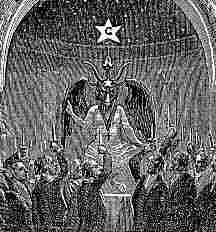
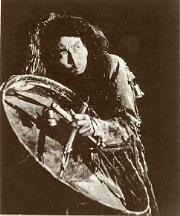 Native Americans have similar rituals, built around peyote, which have the advantage of producing notably less nausea. Apache rituals involved invoking deities by chanting their names and dancing in masks designed to represent the petitioned deity. Peyote was consumed in order to make contact with the spiritual Other, on an astral plane where the shaman could receive information or be endowed with special powers. According to Hallucinogens & Shamanism, a 1973 study:
Native Americans have similar rituals, built around peyote, which have the advantage of producing notably less nausea. Apache rituals involved invoking deities by chanting their names and dancing in masks designed to represent the petitioned deity. Peyote was consumed in order to make contact with the spiritual Other, on an astral plane where the shaman could receive information or be endowed with special powers. According to Hallucinogens & Shamanism, a 1973 study:
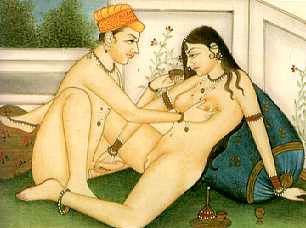 Sex magicians also work with moving mystical energy through the body, which is then used for external purposes. Different forms of yoga are sometimes used to accomplish this goal, such as kundalini yoga, which focuses on moving energy from its point of generation at the root chakra (a focal point just below the genitals) up through the body along the spine.
Sex magicians also work with moving mystical energy through the body, which is then used for external purposes. Different forms of yoga are sometimes used to accomplish this goal, such as kundalini yoga, which focuses on moving energy from its point of generation at the root chakra (a focal point just below the genitals) up through the body along the spine.  Historically, tantric magic (derived from Hindu and Buddhist practices) is similarly obsessed with fluids, but modern practitioners have integrated some of the energy work aspect into various New Agey permutations.
Historically, tantric magic (derived from Hindu and Buddhist practices) is similarly obsessed with fluids, but modern practitioners have integrated some of the energy work aspect into various New Agey permutations.
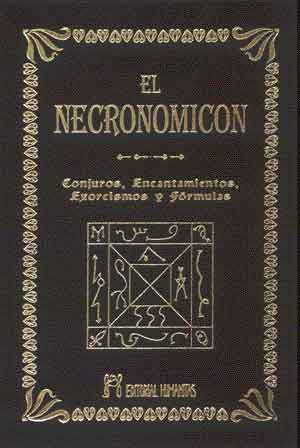 That doesn't stop people from trying.
That doesn't stop people from trying. 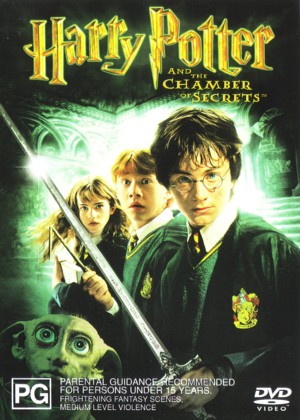 A new version of the Necronomicon pops up every couple of years. All of them have been variations on the basic medieval grimoire model, only much more tedious and with entirely fictional deities and metaphysical structures. Imagine the invocation of Lucifer above, only with twice as many long lists of consonant-stuffed names, and you get the idea. The evil is more unpronounceable than unspeakable.
A new version of the Necronomicon pops up every couple of years. All of them have been variations on the basic medieval grimoire model, only much more tedious and with entirely fictional deities and metaphysical structures. Imagine the invocation of Lucifer above, only with twice as many long lists of consonant-stuffed names, and you get the idea. The evil is more unpronounceable than unspeakable. 